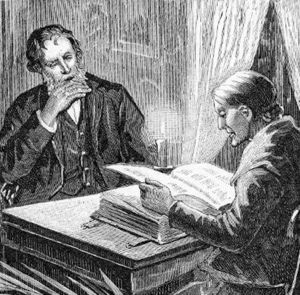Why we read together
During the past half year, many Covenant congregations across the country, including my own, embarked on a journey of reading the entire New Testament together. This was a denominational initiative, with a simple curriculum and books published by Biblica, as well as resources designed to guide the reading in congregational Sunday school hours and in small group meetings in homes. The historical resources for the Covenant Church were drafted by Michelle Clifton-Soderstrom, Chris Gehrz, Hauna Ondrey, and myself, and aimed to highlight how the Bible has historically been read in our tradition and why it matters today (to access a printable PDF of this 12-page booklet, “Covenanters Reading Scripture through History,” visit http://cbe.covchurch.org/cov-connection/ and scroll to the bottom of the page).
If you didn’t know it by now, the Lutheran Pietists that we so often talk about in this magazine were avid readers of the Bible, so much so that they were simply called “readers.” Another fun fact, it was in large part readers like these who pioneered the modern small group ministry, originally called conventicles, in the 1600s. Over the centuries, this has remained a tried-and-true practice for deepening Christian friendships, sustaining congregations, planting churches, and inspiring visions for ministries of all kinds.

I write this column at a low point in the recent history of the United States, as well as for American Christianity. The presidential campaign that we all witnessed was shallow and divisive, often lacked substance, was sometimes downright gross, and was experienced as hateful by many who find themselves on the margins. Some “evangelicals” were vocal in unseemly ways, were spoken about and spoken for, and courted as a voting bloc – even though this group was seldom defined in any coherent way by the media. “What the Bible says” about this or that societal issue became significant in ways that historians will be sorting out for a long time to come.
Over the past thirty years, the people behind the modern run of this magazine have taken it as a central task to gather people to read together. This discussion has involved thoughtful reflections on biblical texts, some church history, a lot of shared testimony, and commentary on a variety of topics pulled from all forms of human endeavor and concern. A foundational principal is the realization that we won’t agree with one another on everything that pertains to the Christian life. We reject ad hominem attacks. We make space for those who write to us in light of our premises (back cover). We affirm those whose primary purpose is to seek to bless others with their words, not to endorse a partisan viewpoint. Our readership includes Republicans, Democrats, and Independents…and that diversity of viewpoints is something we will strive to maintain. Classic values of civility and Christian compassion transcend a great swath of middle ground between the extremes of party ideology – that’s where you’ll continue to find Pietisten.
In this issue, several voices reaffirm these premises. Denny Moon shares his experience and reflections from engaging with his neighbors about the movement to reconcile the conflict between black Americans and law enforcement. Art Mampel, in the poem “Backlash of Goodness,” wonders what careful listening and thoughtful replies can accomplish in the midst of the post-election cacophony of protest and accusation. Continuing our interest in community storytelling, Arvid Adell interviews friend of Pietisten, G. Timothy Johnson, about his adventures in medicine, broadcasting, and authorship. Chris Gehrz shares a tribute for his colleague at Bethel, the late G.W. Carlson, historian of the Baptist General Conference. In a creative essay, Steph Johnson Blomgren sets out on a hopeful investigation of the emotion of fear. Jane and Glen Wiberg discuss how our worship can incorporate honest reflections of our emotions surrounding trauma, lament, and confessions of sin.
As my congregation read through the New Testament this past fall, I marveled at hearing the range of insight that arose in an intergenerational group of readers, with different backgrounds and life experiences. When we asked what each other had noticed in the text, or found challenging or difficult, it was usually the case that we had different answers. Reading together in a spirit of curiosity and with a view to understanding and blessing other people is what the Christian tradition is at its best.
We read together, because when we read apart, we miss so much.
Guds frid – God’s peace
